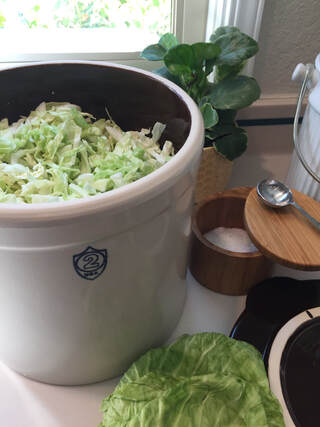Years of antibiotic use, eating sugar-laden food, and eschewing microbe-feeding prebiotic fiber foods are all making you fat—but not for the reason you think. This pattern of poor eating has armed the bad bacteria who live in your gut with the weapons they need to overtake the good guys: probiotics. And when your good gut bugs are depleted, they not only won't be able to fend off weight-inducing inflammation, they also can't help you keep your metabolism humming, your immune system healthy, and your mind keen. It's why gut health is so important. Research suggests that consuming more probiotic foods can help mend your gut and nourish your microbiome. Sauerkraut is rich in fiber, vitamins, and minerals. Its probiotics also help your body absorb these nutrients more easily, which is what makes sauerkraut more nutritious than raw cabbage or coleslaw. 1. SAUERKRAUT IS VERY NUTRITIOUS Sauerkraut is particularly nutritious because it undergoes fermentation, a process during which microorganisms on the cabbage digest its natural sugars and convert them into carbon dioxide and organic acids.
2. IMPROVES YOUR DIGESTION Your gut is said to contain over 100 trillion microorganisms or “gut flora,” which is more than 10 times the total number of cells in your body. Different probiotic strains may provide varying advantages. Thus, consuming a wide variety of strains may give you a broader range of health benefits. In this regard, sauerkraut may have the advantage. Research has reported that one serving may contain up to 28 distinct bacterial strains 3. BOOSTS YOUR IMMUNE SYSTEM In addition to being a source of probiotics, sauerkraut is rich in vitamin C and iron, both of which contribute to a healthy immune system. 4. MAY HELP YOU LOSE WEIGHT Regularly consuming sauerkraut may help you lose weight and keep it off. That’s partly because sauerkraut, like most vegetables, is low in calories and high in fiber. High fiber diets keep you fuller for longer, which may help you naturally reduce the number of calories you eat each day. Sauerkraut’s probiotic content may also contribute to a trimmer waistline. The exact reasons aren’t yet fully understood, but scientists believe that certain probiotics may have the ability to reduce the amount of fat your body absorbs from your diet. 5. HELPS REDUCE STRESS AND MAINTAIN BRAIN HEALTH Sauerkraut promotes healthy gut flora and may increase the absorption of mood-regulating minerals from your diet. Both of these effects help reduce stress and maintain brain health. 6. MAY REDUCE THE RICK OF CERTAIN CANCERS Cabbage, the main ingredient in sauerkraut, contains antioxidants and other beneficial plant compounds that may help reduce the risk of certain cancers. Researchers believe these compounds may help reduce DNA damage, prevent cell mutations, and block the excessive cell growth that typically leads to tumor development 7. MAY PROMOTE HEART HEALTH The fiber, probiotic, and vitamin K2 contents of sauerkraut may contribute to lower cholesterol levels, slight improvements in blood pressure, and a lower risk of heart disease. 8. CONTRIBUTES TO STRONGER BONES Sauerkraut contains vitamin K2, which plays an important role in bone health. More specifically, vitamin K2 activates two proteins that bind to calcium, the main mineral found in bones How to make sauerkrautMaking sauerkraut is easy, simple and inexpensive. Here’s how: Basic Sauerkraut Ingredients
Directions
Keep in mind that the larger the head of cabbage you start with, the sweeter and better your sauerkraut will taste. If you’re impatient to taste your creation, you can do so after 7 days. The longer you allow it to ferment, the stronger the taste will be.
Although I promote the “food first” approach, probiotics are also available in supplement form. If you choose a supplement, look for one with 10-20 billion live CFUs (colony-forming units), as this dose has shown most beneficial in clinical trials. Always look for live cultures. Heat and pasteurization tend to kill the bacteria, which means your body will not reap the benefits. Refrigerated probiotics have a shelf life of about three to six weeks. Selecting a probiotic with a variety of strains is also important, as different strains provide special benefits. Three well-researched and important strains to look for include: Lactobacillus acidophilus, Bifidobacterium longum and Bifidobacterium bifidum. No matter how you decide to consume your probiotics, please keep in mind: although probiotics don’t usually have side effects, if any new food or supplement causes you gastrointestinal distress, discontinue it. Remember—listen to your body; foods affect everyone’s digestion differently!
0 Comments
Leave a Reply. |
HealthstyledHealth | Habits | Hormones Categories
All
Archives
April 2023
|


 RSS Feed
RSS Feed